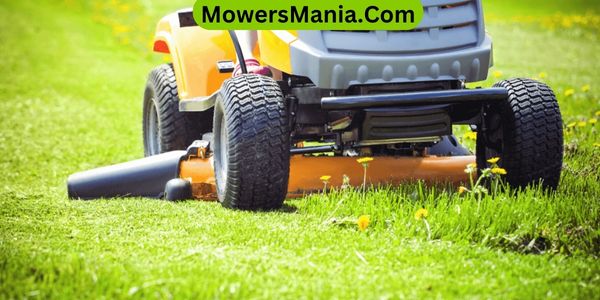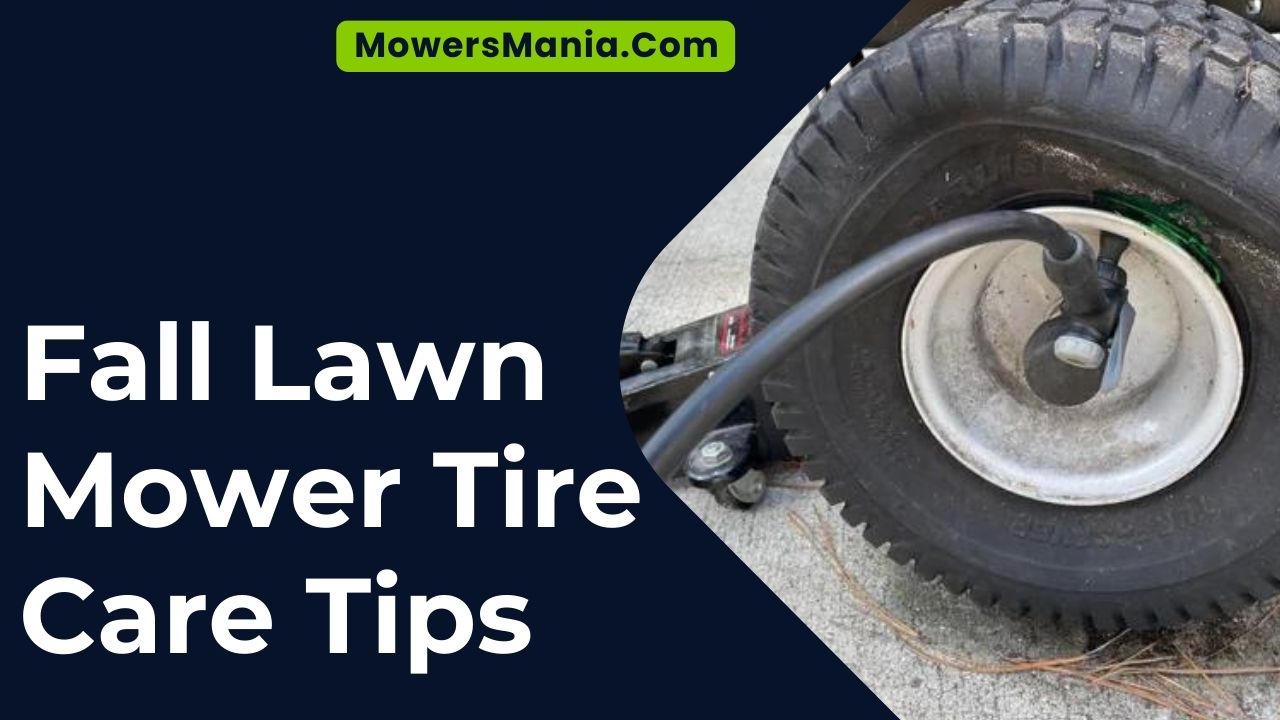You know how a car’s tires need attention before a long road trip? Well, your lawn mower’s tires deserve the same TLC before tackling fall yard work. Neglecting them could leave you stranded in the middle of leaf-covered terrain.
So, here are some quick tips to keep your lawn mower rolling smoothly through the season. First, check the tire pressure to ensure proper traction and handling.

Next, inspect the tread for wear and tear. Remove any debris stuck in the tires and give them a good clean.
Consider rotating the tires for more even wear. And finally, store your mower properly and perform regular maintenance to keep those tires in top shape.
Tire Pressure Check
When checking your lawn mower tire pressure, start by using a tire pressure gauge to measure the current air pressure. This simple tool will give you an accurate reading, allowing you to determine if the tires need more air.
Proper tire pressure is crucial for maintaining a healthy lawn mower and ensuring optimal performance.
Underinflated tires can lead to poor traction, uneven cutting, and increased fuel consumption. On the other hand, overinflated tires can make the ride uncomfortable and increase the risk of tire damage.
Take the time to consult your lawn mower manual or the sidewall of the tire to find the recommended pressure range. Once you have the reading, add or release air as needed to reach the correct pressure.
Remember to check the tire pressure regularly, especially at the start of the mowing season and after long periods of storage.
By keeping your lawn mower tires properly inflated, you’ll not only improve the quality of your lawn’s cut but also prolong the life of your equipment.
Tread Inspection
Regularly inspecting the tread on your lawn mower tires is essential for maintaining optimal performance and safety.
The tread provides the necessary traction for maneuvering through various terrains, and a worn-out tread can compromise the mower’s stability and efficiency.
To ensure your mower tires are in top condition, conduct a visual inspection of the tread pattern. Look for uneven wear, bald spots, or any signs of damage such as cuts or punctures.
Use the following table to evaluate the condition of your lawn mower tire treads:
| Tread Condition | Action Needed |
|---|---|
| Even wear across | Good to go |
| Uneven wear | Rotate or replace |
| Bald spots | Replace |
| Cuts or punctures | Replace |
Clean and Debris Removal

To maintain the optimal performance and safety of your lawn mower, regularly clean the tires and remove any debris that may have accumulated.
Cleaning the tires is essential for preventing grass clippings, mud, and other debris from building up and affecting traction.
Begin by removing the tires and using a brush or compressed air to clear away any accumulated debris.
Check the tire treads and sidewalls for any embedded debris that could cause punctures or affect the tire’s performance.
Inspect the inner rims for grass and dirt accumulation, as this can lead to rust and corrosion. After cleaning, ensure that the tires are thoroughly dry before reattaching them to the mower.
Regularly removing debris from the tires not only enhances traction but also prevents excessive wear and tear. It also reduces the risk of punctures and improves overall maneuverability.
Neglecting to clean the tires can lead to issues such as reduced traction, uneven cutting, and potential damage to the tire itself.
Tire Rotation
You should consider rotating your lawn mower tires at least once a year to ensure even wear and prolong their lifespan.
Rotating the tires helps distribute the wear more evenly, preventing one tire from wearing out faster than the others.
This simple maintenance task can ultimately save you money by extending the life of your tires and improving the overall performance of your lawn mower.
When rotating your lawn mower tires, it’s important to follow a specific pattern to ensure balanced wear. Use the following pattern as a guide:
| Front Left | Rear Left | Front Right |
|---|---|---|
| Rear Right | Front Left | Rear Left |
By following this rotation pattern, you can promote even wear on all four tires, helping them last longer and maintain better traction on your lawn.
Regular tire rotation is a key part of overall lawn mower maintenance and can contribute to a smoother, more efficient mowing experience. Make it a part of your annual fall maintenance routine to keep your lawn mower in top condition.
Storage and Maintenance

For optimal storage and maintenance of your lawn mower tires during the fall, it’s important to inspect them for any signs of wear or damage before storing the mower for the season.
Start by cleaning the tires to remove any grass, dirt, or debris that could cause deterioration during storage.
Inspect the tread for uneven wear, bald spots, or cracking. If you notice any of these issues, it may be time to replace the tires to ensure safe and efficient mowing next season.
Once the tires are clean and inspected, it’s crucial to store the mower properly. Ideally, store the mower in a cool, dry place to prevent the tires from deteriorating due to extreme temperatures or moisture.
If possible, elevate the mower on blocks to prevent the tires from resting directly on the ground, which can cause flat spots or deterioration.
Additionally, periodically check the tire pressure during storage, as tires can lose air over time.
Frequently Asked Questions [FAQs]
Can I Use a Different Type of Tire on My Lawn Mower, Such as a Solid Rubber Tire Instead of an Air-Filled One?
Yes, you can use a solid rubber tire on your lawn mower instead of an air-filled one. Solid rubber tires are puncture-proof and require less maintenance. They provide a smooth, stable ride and are a good alternative.
Is It Necessary to Use a Tire Sealant or Puncture-Resistant Tire Liner for My Lawn Mower Tires?
Yes, it’s necessary to use a tire sealant or puncture-resistant tire liner for your lawn mower tires. This helps prevent punctures and keeps the tires properly inflated, ensuring smooth operation and reducing the need for frequent replacements.
How Often Should I Replace My Lawn Mower Tires, and What Are the Signs That They Need to Be Replaced?
You should replace your lawn mower tires when you notice extensive wear, cracks, or bulges. Inspect them regularly for signs of damage or degradation. Typically, mower tires need replacement every 3-5 years, depending on usage and maintenance.
Are There Any Specific Tire Brands or Models That Are Recommended for Use on Different Types of Terrain (E.G. Hilly, Flat, Uneven)?
For different terrain types, consider brands like Carlisle, Kenda, or Turf Saver. They offer tires designed for hilly, flat, or uneven surfaces. Check the tread design and durability to ensure they’re suitable for your specific mowing conditions.
What Are Some Common Mistakes People Make When Storing Their Lawn Mower for the Winter That Can Damage the Tires?
When storing your lawn mower for winter, avoid leaving it in direct sunlight, which can cause tire cracking. Also, don’t let the tires sit on a damp surface, as moisture can lead to dry rot.
Conclusion
Now that you’ve learned these fall lawn mower tire care tips, you can keep your mower running smoothly and efficiently all season long.
By regularly checking tire pressure, inspecting the tread, cleaning debris, and rotating tires as needed, you can extend the life of your mower tires and ensure optimal performance.
Don’t forget to properly store and maintain your mower during the off-season to keep it in top shape for next year.



